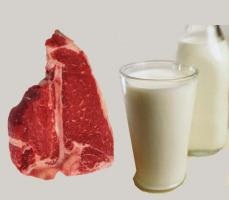While our parsha contains over fifty different mitzvot, one in particular is an everyday concern for most Jews: the prohibition of cooking meat with milk. This law, together with its Rabbinical extensions, is so important that it constitutes the heart of the standard curriculum for modern-day Rabbinical ordination.
The prohibition applies to the milk and meat of any permitted animal. However, one message of the mitzva has its roots in the original wording: not to cook a calf (the young of the species – PC) in its own mother’s milk.
There is an obvious incongruence in this practice. The milk was produced by the mother in order to give life to the kid, and now we seethe the calf in this same milk after its death. The milk produced by the mother to nourish her offspring is now feeding the very one who slaughtered that offspring! It is as if we were seeking to nurse and nourish the forces of death and cruelty (the slaughtered calf and the human who took it from its mother), instead of life and loving kindness! (Based on Zohar Mishpatim.)
There is a related negative symbolism in consuming any milk with any meat – which is also forbidden by the Torah.
Eating animals can naturally symbolize assimilating their bestial qualities, as indeed it does in many pagan cultures; and the laws of kosher meat are fraught with the symbolism of overcoming these base qualities. We only eat docile ruminants; we don’t hack or hunt them but rather slaughter them in a rapid and humane way; we salt the meat to get rid of the blood, which more than anything else symbolizes the animal’s lower, bestial nature. And while meat may be eaten uncooked, the gemara indicates that meat is best eaten well cooked – to overcome its natural toughness (Shabbat 42b a.e.).
Conversely, there are also “neutral” foods, like uncultivated vegetables, which are generally not subject to any halakhic restrictions. (Except in the shemitta year in Israel.)
Milk occupies a unique intermediate status. According to Jewish tradition, the milk is formed from the blood – the ultimate embodiment of bestiality. However, once it turns to milk, it is permissible without any further preparation. Apparently the negative symbolism of the blood has been fully overcome! Just as the milkhas physically escaped from the beast’s flesh and blood and collected separately in the udder, so has it escaped the stigma of bestiality.
(We find a similar intermediate status in secular culture. Many people are vegetarians – they put milk in the same category as vegetables. A few are vegans – they view milk as an animal product no different from meat.)
Nonetheless, the milk remains an animal food. After all, it must come from a permitted animal. This suggests that there is still a latent blood-like potential in the milk, which can be dangerously reawakened by bringing it back into contact with the meat.
The parallel symbolism applies in the opposite direction. By slaughtering and salting the meat, we have worked hard to subdue the negative qualities meat signifies. Bringing it back into contact with milk, which comes from the blood, is like reawakening the latent bloodthirsty quality of the beast. This is particularly true if we cook the meat together with the milk. The same process which is meant to complete the “taming” of the meat is now a conspirator in its regression. (Based on Likutei Halakhot, Breslav.)
Rabbi Asher Meir is in the process of writing a monumental companion to Kitzur Shulchan Aruch which beautifully presents the meanings in our mitzvot and halacha. Rabbi Meir – who had given a series on Business Halacha at the Center, has just ended a series of shiurim on Tuesday mornings on the Meaning in Mitzvot. We are planning on having him back for another series… soon, IY”H.
Rabbi Asher Meir is the author of the book Meaning in Mitzvot, distributed by Feldheim. The book provides insights into the inner meaning of our daily practices, following the order of the 221 chapters of the Kitzur Shulchan Aruch.
The words of this author reflect his/her own opinions and do not necessarily represent the official position of the Orthodox Union.
